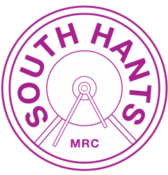These layouts were featured at our 2018 Exhibition
End of the Line (7mm scale, O gauge)
Tim Crockford
The End of the Line represents the distribution point of a very small coal mining operation in the early 1960s. Never very busy, the output of the mine is divided between distant industry, transported away by rail, and local demand which is handled by road haulage.
The coal from the mine is delivered to the distribution point by a 2ft narrow gauge railway. The excellent KBscale tipper wagons have been made to operate and discharge their load into either a conveyor or direct into a waiting standard gauge mineral wagon.
The road haulage lorries are radio controlled and have been converted from commercially available die-cast models. The layout was originally built by Giles Favell but the stock and the lorries shown today are by the current owner.
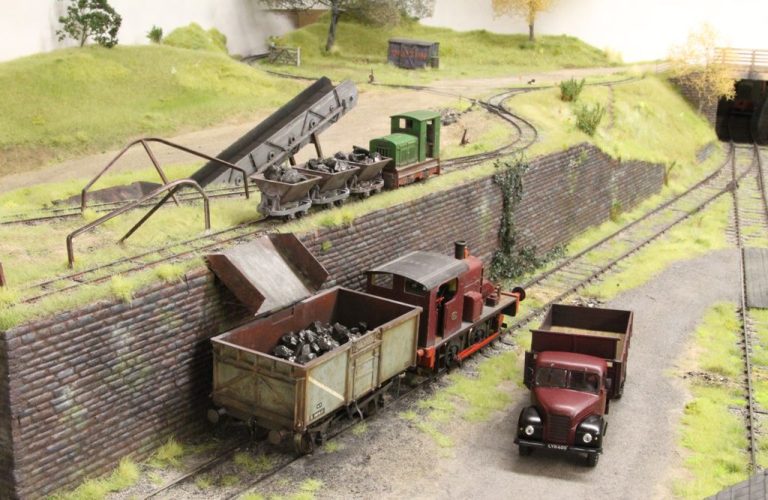
Horselunges (4mm scale, P4 gauge)
David Nicholson
Not far from the bottom edges of the Sussex Weald lies the Dicker Tramway, a small independent light railway connecting the brick kilns of Dicker with the market town of Owlsham. An intermediate station serving the market town of Horselunges along with its flour mill and a private industrial siding form the subject of the scene depicted. The stock is a mixture originating from a variety of sources.
All the buildings on the layout come from prototypes within one mile of the East Sussex village of Hellingly as does the layouts curious name, being that of a nearby manor house.
The layout is believed to have been built originally to EM Gauge by Alan Woodford and featured in the September 1996 edition of the Railway Modeller. It was later converted to P4
The stock has all been built by and lent to us by Neil Kinison from his Edford layout.
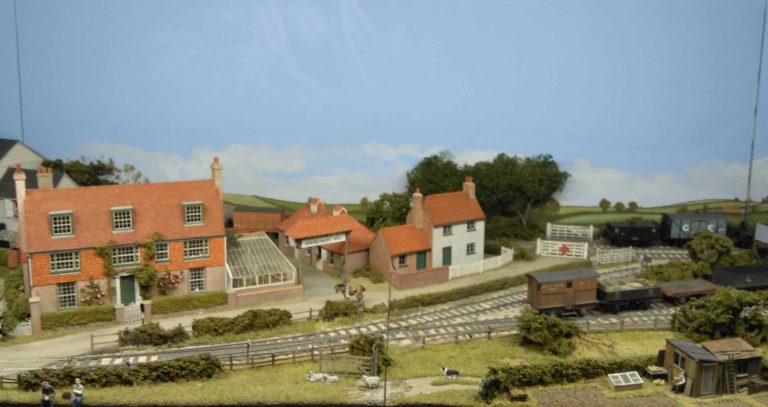
Outwell Village (4mm scale, OO finescale)
Alan Price
We are pleased to present Alan Price’s beautiful depiction of Outwell Village on the iconic Wisbech & Upwell Tramway.
The Wisbech and Upwell Tramway opened to traffic on the 20th August 1883 only as far as Outwell, and then on to Upwell on the 8th September 1884. Between the years of 1945 to 1950 the line saw the most activity, when it was not uncommon to see double headed trams with 60 fruit vans in tow. Steam trams were the mainstay of the motive power in the early years, with diesels taking over until 23rd May 1966 when the line closed to traffic.
Outwell Village is the largest intermediate depot on the tramway. Our model spans a time frame from just after the Second World War up to the lines closure, as the location changed little during that time. We have stock to cover both the L.N.E.R and British Railways periods. All buildings have been scratch built.
Watch out for the Enthusiast’s Special!
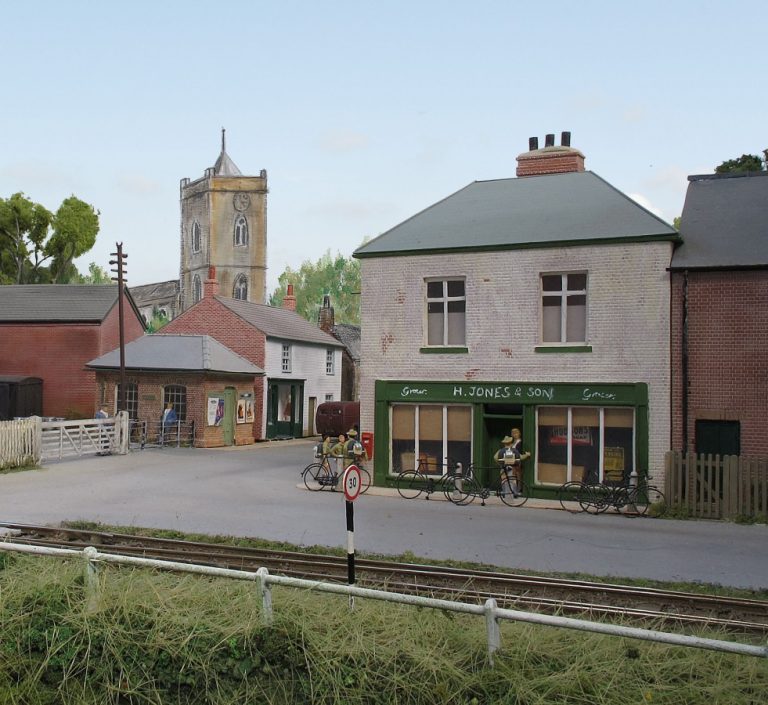
Trowland (1:64th scale, S gauge)
Trevor Nunn
Trevor Nunn’s new layout ‘Trowland’ is the terminus of a Midland and Great Northern Joint Railway branch line in North Norfolk. The layout is set firmly in the 19th century
The Midland and Great Northern Railway connected southern Lincolnshire and north Norfolk. It developed from several local independent concerns and was incorporated in 1893. It was jointly owned by the Midland Railway and the Great Northern Railway.
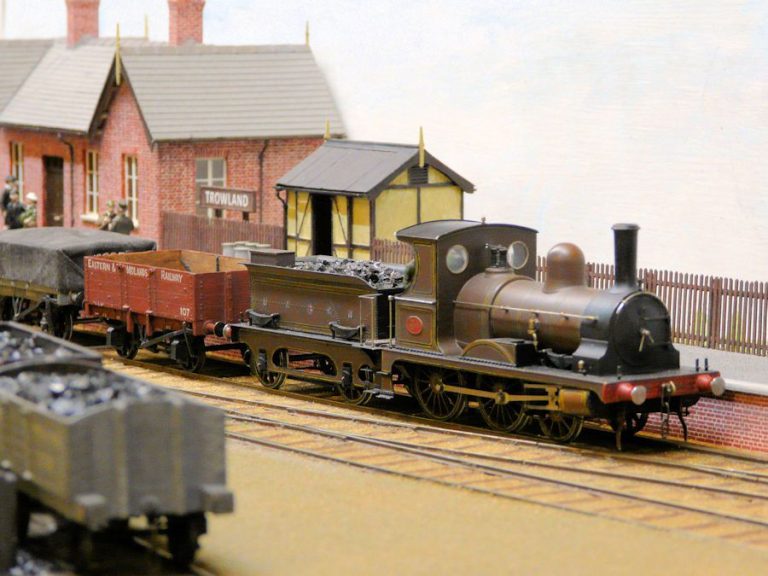
Ferring (4mm scale, P4 Gauge)
Michael Ball
Ferring is the terminus of a fictional branch off the Brighton to Portsmouth line near Goring, Sussex, set in 1911.
We try to portray typical L.B.S.C.R. practise of the time and to capture a ‘Brighton’ atmosphere; most of the buildings are based on real ones.
Dictated by the track layout, the somewhat complicated signals are hand made using parts from various manufacturers.
Rolling stock and locos are mainly from kits. Liveries include Marsh’s umber for passenger loco’s and black for goods engines. Some retain their Stroudley colours where the goods engines are dark green.
By 1911, the coach livery was a rather dull brown, but we have some in the earlier umber and white. The set of four-wheelers is in varnished mahogany.
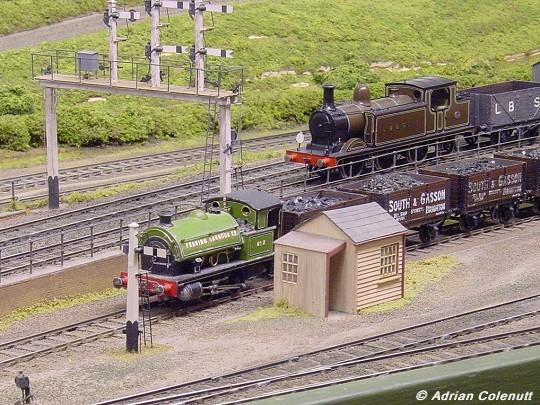
Widley and St George (4mm scale, OO Gauge)
South Hants MRC
One for our younger visitors. Come and drive trains pulled by Thomas, Percy, Gordon and more of their friends
Hope-under-Dinmore (4mm scale, EM gauge)
South Hants MRC
The Shrewsbury & Hereford Railway Company obtained an Act of Parliament in 1846 to build a narrow gauge (4’ 8½” gauge) railway from Shrewsbury to Hereford. The line covered a distance of 50.5 miles and work commenced in 1850. The line opened from Shrewsbury to Ludlow on the 21st April 1852. The Hereford section of the line opened on the 30th July 1853 for goods traffic and for passengers on December.
In 1862 the Shrewsbury and Hereford Railway was jointly leased by the London & North Western Railway (LNWR), the Great Western Railway (GWR) and the West Midland Railway (WMR). By 1871 the WMR had amalgamated with the GWR, so the LNWR and the GWR jointly acquired the Shrewsbury & Hereford line.
In 1887 the traffic levels on the line were increased by the opening of the Severn Tunnel and in May 1892, the conversion of the broad gauge lines to standard gauge to the west of Exeter meant even longer distance through services on the line.
A station was built to the south of Dinmore tunnel, Dinmore, which was closed in 1958.
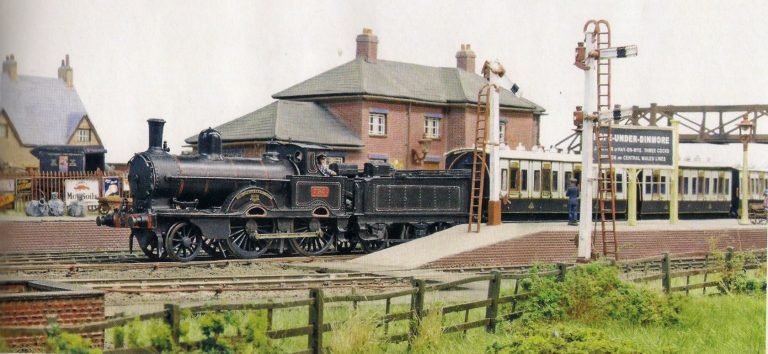
Leysdown (4mm scale, P4 gauge)
Adrian Colenutt
Welcome to the Leysdown, a model railway layout portraying, in 4mm to the foot scale, the terminus of the Sheppey Light Railway as it would have appeared in the early 1930s under Southern Railway ownership.
The Isle of Sheppey is an island off the northern coast of Kent in the Thames Estuary, some 46 miles to the east of London. “Sheppey” is derived from the ancient Saxon “Sceapige”, meaning isle of sheep, and even today the extensive marshes which make up a considerable proportion of the island provide grazing for large flocks of the animals.
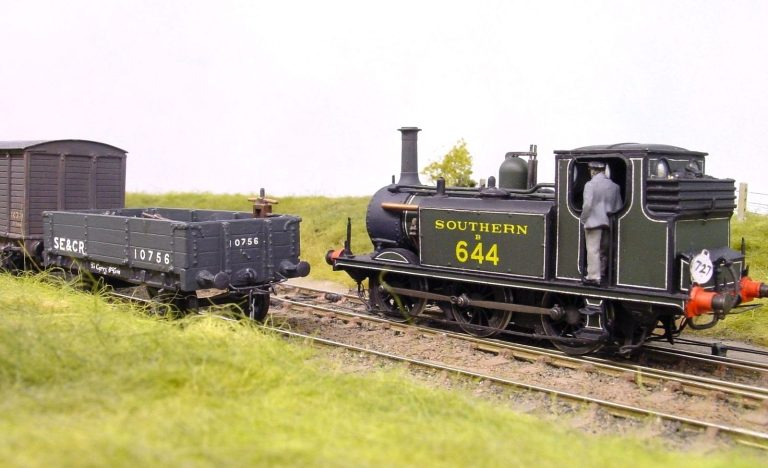
Sherton Abbas (7mm scale, O gauge)
David Stone
Sherton Abbas is a 7mm scale representation of a Great Western Railway branch line terminus and is set in the Edwardian era circa 1905.
The name Sherton Abbas comes from Thomas Hardy’s novel “The Woodlanders” – quite what he would have made of the railway is anyone’s guess!
The buildings are scratch built from plastic card and are based on William Clarke designs.
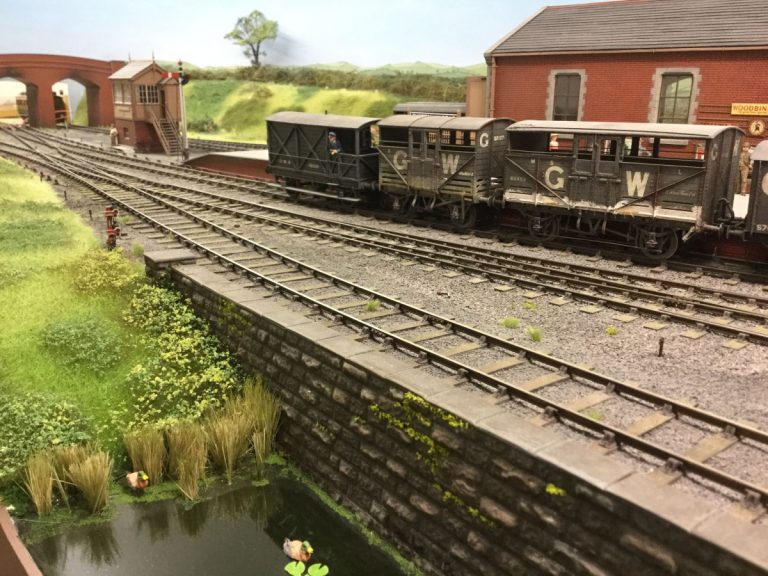
Stoke by Nayland (4mm scale, P4 gauge)
David Hawkins
In 1867 the Great Eastern Railway opened a 35 mile cross country route from Colchester to Stowmarket. The line was never as successful as anticipated and lived a quiet existence for 100 years until closure in 1967. It did however prove to be a useful avoiding line, taking pressure of the Colchester to Norwich mainline at busy times. Stoke by Nayland station itself was kept busy by the presence of a granary and a dairy.
Of course, none of this actually happened. Stoke by Nayland remains a pretty village in the heart of Constable Country but never had the pleasure of being served by the railway.
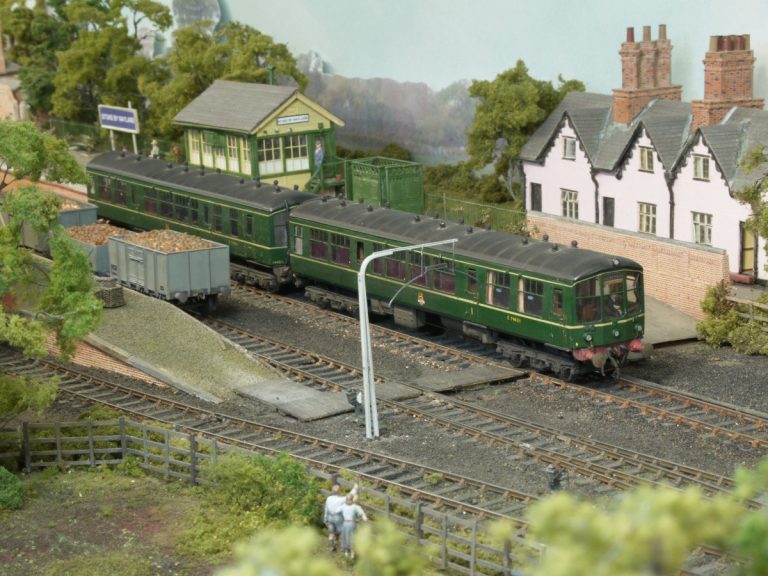
Banbury (2mm scale, N Gauge)
Ian Lampkin
Banbury station lies on a busy cross country route between Birmingham and Didcot, where it joins the Great Western Mainline. The Chiltern Railways mainline towards London Marylebone diverges a few miles South at Aynho Junction.
There is a lot of freight traffic, mainly containers to and from Southampton. Chiltern Trains operate the majority of passenger services but Cross Country trains have two an hour each way and First Great Western have a local service that terminates at Banbury.
Until January 2011 there used to be the Wrexham and Shropshire loco hauled passenger trains. However Chiltern Trains have now introduced loco hauled on weekdays and weekends between London and Birmingham with a few continuing to Stourbridge and Kidderminster.
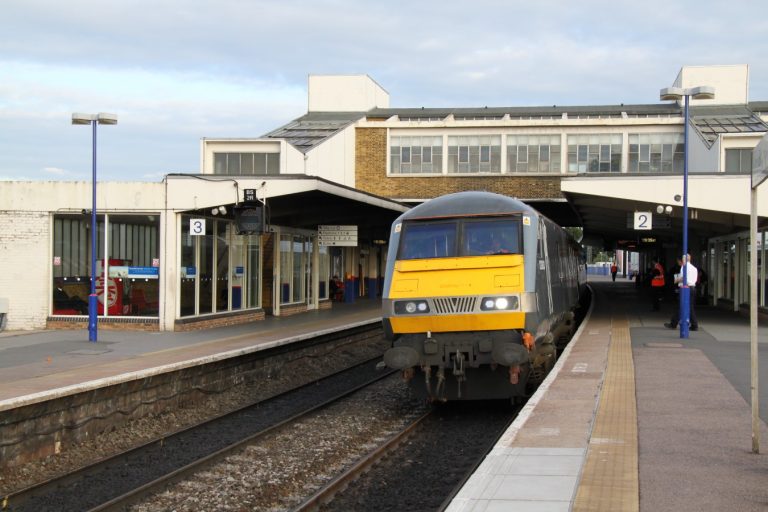
Fulton Terminal (3.5mm scale, HO Gauge)
Andrew Browne
Fulton Terminal was situated on the East River and was operated by the New York Dock Railway. It was one of a large number of similar rail terminals around the Upper New York Bay and Hudson River area, connected together by the river. In 1954, the railroad companies employed almost 2000 vessels in this trade … tugs, barges, carfloats (a barge fitted with rails) and various special craft. All bar one closed following the introduction of containerisation, Fulton Terminal closing in 1982.
The model is closely based on the original and is full size, but is not intended to be an exact replica.The line continued south to serve Piers 17 & 18, and north to team tracks (public sidings) together with the Jehovah’s Witnesses Watchtower printing works.
It is Sunday morning, the docks are idle as Dockers have the day off, ships crews have a day in port, and ship owners fret. Maintenance crews are at work as the lines north and south are closed for track repairs. Even the Brooklyn Queens Expressway is quiet. Hard at work are the Fulton Terminal switching (shunting) crews and tug crews, a chance to earn overtime and to catch up on repositioning freight cars and carfloats ready for a busy Monday.

Notes:
First Title widget in each column has no top border, margin or padding – don’t use these further down the page.
The second Title widget in each column has 30px margin, 10px padding and a border above the text – duplicate these for additional layouts.
For text & images, just use normal widget from the left-hand widget area … drag them as required.
Refer to previous years’ exhibitions for comparison.
